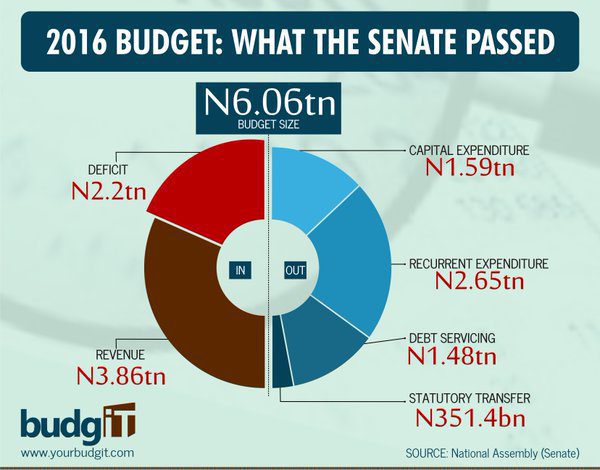Economic Issues
Where is the 2016 budget implementation report? -By Uchenna Uwaleke


Up till the time of writing, the third and fourth quarter 2016 budget implementation reports had not been uploaded on the website of the Budget Office. Section 30 of the Fiscal Responsibility Act 2007 charges the Budget Office with the responsibility to monitor and report on budget implementation. In subsection 1, it states that “the Minister of Finance, through the Budget Office of the Federation, shall monitor and evaluate the implementation of the Annual Budget, assess the attainment of fiscal targets and report thereon on a quarterly basis to the Fiscal Responsibility Council and the Joint Finance Committee of the National Assembly”. Subsection 2 requires that “the Minister of Finance shall, cause the report prepared pursuant to subsection (1) of this section to be published in the mass and electronic media and on the Ministry of Finance website, not later than 30 days after the end of each quarter”.
In view of the fact that the 2016 financial year was extended to May 5, 2017, due to the late passage of the 2016 Appropriation Bill, the Ministry of Budget and National Planning (which now has that responsibility) has a little more time to come up with a consolidated budget execution report in line with Section 50 of the FRA 2007 which mandates that such should be produced not later than six months after the end of the financial year. Nevertheless, the third and fourth quarter budget implementation reports ought to have been in the public domain by now going by the provisions of Section 30 of the FRA 2007.
Although the budget process involves both budget preparation implementation and control activities, the public discourse has often been about the numbers in the budget document and seldom dwells on the other key aspects of implementation and control. This is due, in part, to the fact that in-year implementation reports are not made available in time in line with best practice and even when quarterly reports are eventually produced, they are not dated; contain scanty information which sometimes is at variance with data from key statistical agencies of government.
For instance, the last quarterly budget implementation report on the website of the Budget Office is that of the second quarter of 2016. This document is not dated to enable an objective assessment of compliance with the provisions of the FRA 2007. Regarding the capital expenditure performance reported in Section 3.5.4, not much information is supplied beyond references to the amount of funds released/cash-backed as well as utilisation rates of funds by six MDAs which do not enable proper interrogation of the implementation outcomes. In Section 3.5.5, it states that the “2016 fiscal framework projected a quarterly deficit of N551.19bn to be financed through earnings from privatisation proceeds of N2.5bn, FGNs share of signature bonus of N0.19bn, recovery of misappropriated funds of N87.58bn, foreign borrowing of N158.97bn, domestic borrowing (FGN bonds) of N295.70bn and sale of government properties of N6.25bn”. It goes ahead to claim that “in the second quarter of 2016, none of the financing items including domestic borrowing through FGN bonds yielded anything”.
This is inconsistent with data obtained from the Debt Management Office regarding the FGN domestic debt stock by instruments between April 2016 and June 2016 which showed an increase in the FGN Bonds of about N556bn. Total domestic debt stock as of March 31, 2016, stood at N9.97tn out of which the FGN Bonds accounted for N6.914tn or 69.5 per cent. By the end of June 2016, the total domestic debt profile had risen to N10.6tn of which N7.47tn (or 70.46 per cent) were FGN Bonds. Again in Section 3.5.2 on debt service, it reports that a total of N567.92bn was released for the half-year period in respect of domestic debt servicing whereas the actual domestic debt service published by the DMO for the period is N641.68bn (January – March N424.63bn; April-June N217.05bn). By implication, the 2016 second quarter budget implementation report is inaccurate in respect of the performance of financing items.
It is a matter of concern that the International Budget Partnership keeps reporting that in terms of budget transparency, Nigeria lags behind peer countries like South Africa which ranks very high in the Open Budget Index. The international organisation, which monitors budgetary processes across countries, defines budget transparency as the “the amount, level of detail and timeliness of budget information governments are making publicly available”. In its latest Open Budget Survey, it observes that “as of December 31, 2016, the government of Nigeria makes only four of eight key budget documents publicly available online in a timeframe consistent with international standard”. These include the Executive Budget proposal, Enacted Budget, Year-end report and Audit report. However, it notes that “Pre-budget statement is published late;Citizens Budget is not available online; Mid-year review is not produced while In-Year Reports are produced for internal use”. Part of its recommendation is that Nigeria should publish In-Year Reports (monthly/quarterly) on the relevant government website in a timely manner. As per the OECD’s Best Practices for Budget Transparency, the In-Year Reports should be published within at least one month of the end of the period they cover (for example, the monthly report for the month of January should be published before the end of February).
The benefits of timely quarterly implementation reports cannot be overemphasised. They ensure that the yearnings of the citizens are satisfied regarding the efficient and optimal use of public funds especially in an era of rising public debt profile. According to data recently released by the Debt Management Office, the country’s total debt stock rose to N19.16tn at the end of March 2017 from N16.29tn recorded at the end of June 2016 since the last quarterly implementation report was made public. Detailed and timely quarterly reports should help to shed light on how the huge debt proceed was used during the period.
The absence of timely In-Year reports undermines the effectiveness of the government’s Zero Based Budgeting system which requires the MDAs to justify every item of revenue and expenditure as well as projects and programmes included in the budget. Such justification is made nearly impossible without a proper assessment of the financial commitment of projects and programmes in the previous year’s budget as well as their socio-economic impact. It all speaks to timely release of budget implementation reports especially against the backdrop of the recent Executive Order by the Acting President to the effect that “all Agencies, whether or not listed in the Fiscal Responsibility Act, shall, on or before the end of July every year, cause to be prepared and submitted to the Minister of Finance and the Minister of Budget and National Planning their annual budget estimates”. No doubt, timely production of In-year reports will help to guide and fast-track budget formulation for the coming year.
Indeed, budget debate should not end with the President’s assent. The National Assembly, Fiscal Responsibility Commission, Civil Society, the Press and the general public should regularly review quarterly implementation reports to monitor if money is being spent as planned. But this is only possible if in-year budget reports are made public in time. To this end, the Budget Office, particularly the Budget Monitoring and Evaluation Division, should be strengthened to champion this task in a timely fashion.




















